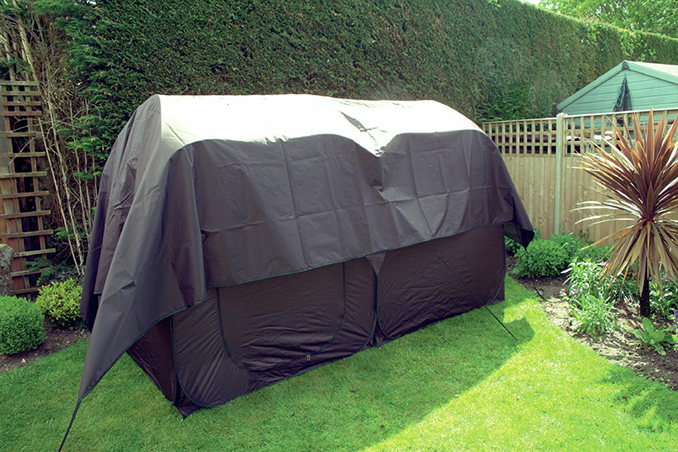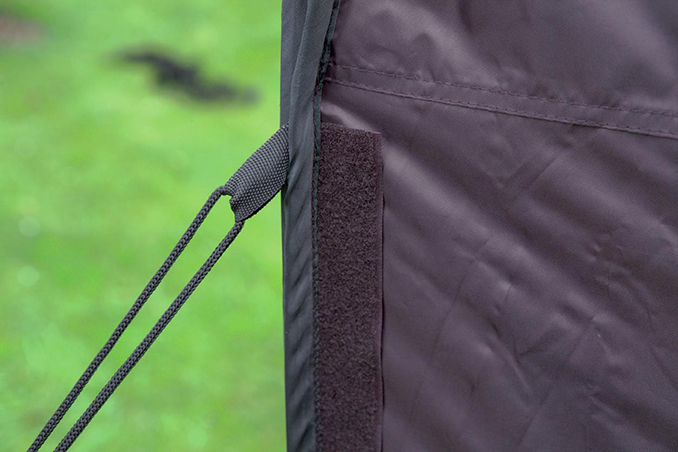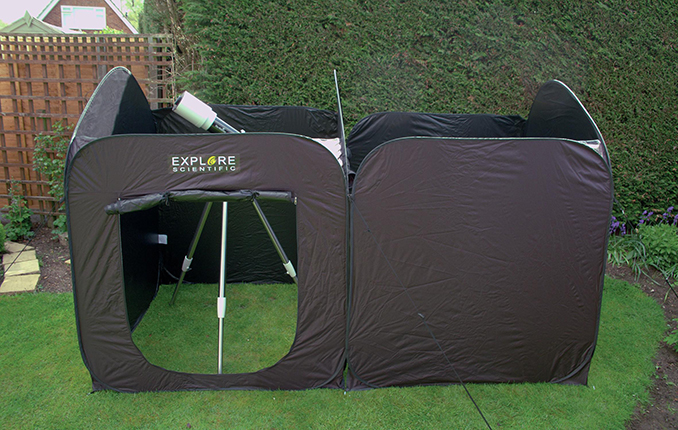
If you asked a group of keen astronomers for their priorities on an equipment wish list, it’s quite likely that most would select their dream telescope and mount or camera, closely followed by an observatory. It’s a train of thought that’s easy to follow, because in an observatory your equipment is always set up and ready to go at a moment’s notice, which means that you can make the most of every patch of clear sky.
And if you have to assemble your telescope for every observation, then there’s nothing quite as frustrating as spending 30 minutes setting up the instrument for a crucial observation only for a blanket of cloud to roll in. An observatory also protects you from the wind, which means that you can stargaze in greater comfort and your telescope or camera won’t get the jitters. An observatory also affords some protection from dew, allowing you to view or image for longer.
The Explore Scientific pop-up observatory tent is feasible for a single person to set up
Before you splash out on that dream dome or roll-off roof astro-shed, there are some cons to static observatory ownership beyond just cost. Most of us have suburban gardens with everpresent light pollution and compromised sky access (how often has your favourite planet played hide-and-seek behind your neighbour’s tree or house?). Plus, thermals from nearby buildings can generate poor localised seeing. Furthermore, certain types of astronomical observation are location specific – eclipses or lunar, planetary and asteroid occultations, for example – so you may have to travel if you want to see them.

Observatory tents
If a static observatory is ruled out because of cost, a lack of garden, poor viewing prospects or the need to escape street lights, then what does one do? The obvious option for the observer who has to travel to a dark-sky location – and, let’s face it, that’s many of us – is some sort of telescope tent. Canadianbased company Kendrick Astro Instruments is an established provider in this area, and currently Omegon markets a three-metre-wide octagonal bell tent observatory with a removable roof.
While the offerings from Kendrick and Omegon are relatively straightforward for any seasoned camper to erect, those unaccustomed to spending time under canvas will likely balk at the challenge of setting up in the dark, particularly if one is observing alone. Fortunately, there is a quick-to-deploy alternative, one that even those who are averse to camping can get to grips with. Just as importantly, it’s feasible for a single person to set up: welcome to the Explore Scientific pop-up observatory tent.

Delivery and first impressions
The Explore Scientific pop-up observatory arrives at your door in a single 70 by 70 by 13 centimetre shipping carton, whose contents have a net weight of just seven kilograms – hence this is a relatively lightweight and easy-to-store product. Inside the box you will find the main tent, an extension tent (more on this in a moment), a top rain cover, a dozen guy-ropes with tensioners, plus a dozen ground stakes (note: you will need to provide your own mallet). Both the main and extension tent are made of a double-stitched nylon polyamide material that is supposedly waterproof, UVprotected and black-out coated. It certainly gives every appearance of being durable and is very opaque, even to sunlight.

The appeal of pop-up tents
Sometimes called self-erecting tents, pop-ups gained popularity as children’s sun-shelters or beach huts, but they have grown in sophistication in recent years. Unlike a traditional tent that uses jointed poles to give the structure shape and rigidity, a self-erecting tent such as the one reviewed here has a shaped, sprung-steel wire frame sewn into the fabric that’s coiled into a circular shape when the tent is stored. Once you remove the pop-up from its bag, merely toss it into the air and it assumes its shape as it opens to full size. All that needs to be done now is to stake the tent corners into the ground, attach further stakes as anchors for the guy-ropes to give the structure rigidity in windy conditions, and you’re done.

First set up
Both the main Explore Scientific observatory tent and the extension tent plus cover reside in a polythene bag within the shipping box, so you may wish to retain the latter and beef up its sides and corners with some duct tape or similar so that you’ll have something to protect the product when it’s not in use. While it would have been nice for Explore Scientific to provide some form of zip-up bag with carrying handles to hold all of the popup observatory’s components, I realise that these things are manufactured to a price. Thankfully, such holdalls are inexpensive to buy on Amazon or eBay.

Anyone with a modicum of camping experience under their belt will discover that the Explore Scientific observatory tent is almost ridiculously easy to erect, which is fortunate as the review model was not supplied with a manual of any kind. Thankfully for novices, the support pages of Explore Scientific’s website (explorescientificusa.com) provides a four-page PDF version that you can read online or print out.
While it is quite feasible for an adult to assemble the Explore Scientific pop-up tent by themselves in the dark with illumination provided by a headtorch, I would recommend a trial-run with a friend during the daytime – particularly if it’s likely to be windy. The guy-ropes are unattached when you buy the product, so you will need to tie them all on securely in the daytime first to save time and hassle when you reach your observing site.
The main tent
Looking somewhat like a child’s drawing of a house, the central part of the Explore Scientific pop-up observatory tent is almost a four-sided cube with walls 1.47 metres wide and 1.52 metres high, with opposite gable ends rising to a maximum height of 1.82 metres. On one gable end there is a zipped central door 0.91 metres wide by 1.06 metres high, with another door of identical size in the centre of one of the side walls. These door flaps may be rolled up and tied at the top by strings. There is no groundsheet, so your telescope’s tripod stands on the soil or grass.

The bottom four corners of the main tent have loops for the ground stakes, plus there are a further four loops 1.2 metres above the ground on the corners of the walls for the guy-ropes that you secure to four more ground stakes placed further away. Even on calm nights you will wish to deploy the guy-ropes because it gives the structure the rigidity to support the top rain/dust cover (the latter is conveniently oversized to seal out moisture and spray, and has corner loops for its own guy-ropes).
I imagine that the majority of the Explore Scientific pop-up observatory’s users will erect just the main tent. Having pre-attached the guy-ropes during the day, the first time I set it up by myself took just ten minutes. You might think it would feel small, but a cuboid 1.47 metres wide by 1.52 metres high is deceptively spacious. By coincidence, the main tent has almost exactly the same internal dimensions as my former wooden observatory with gull-wing roof panels from which I successfully operated a 280mm Celestron Schmidt–Cassegrain telescope on a CGEM German equatorial mount for a few years.
The Explore Scientific pop-up observatory is best suited to catadioptric or relatively short optical tube assembly instruments on tripods
The extension tent
The annexe to the main tent is intended to be used as a computer/operations room, or for supplementary storage. It doesn’t have a groundsheet either, so you may wish to consider getting an old piece of 1.5-metre square carpet or vinyl to stand on. The three-walled extension tent has the same overall dimensions as the main pop-up observatory and attaches to the outside edges of the main tent’s gable end (the one with the door) via a pair of three-centimetres-wide by 90-centimetres-long vertical strips of Velcro.
Disassembly
Is the pop-up observatory just as easy to disassemble and pack away? Yes, with a little bit of practice. I found that it was best first to collapse the structure to a two-dimensional, single-sided form and, while one corner is folded over towards its opposite number, give the frame a slight corkscrew twist. In this way both the main and extension tents coil up upon themselves, forming discs just 70 centimetres in diameter for easy storage.

Conclusions
Since both its main and extension tents have side walls 1.52 metres high, the Explore Scientific popup observatory is best suited to catadioptric or relatively short optical tube assembly instruments on tripods whose height places the axis of their mount around a metre above the ground. It follows that low-slung instruments such as Dobsonians will have quite restricted views.
However, if you are careful with the orientation of your pop-up observatory, you can fold back one wall of the extension tent and observe from that, so even Dobsonian users can benefit. While initially sceptical of its effectiveness, I used the pop-up observatory extensively for both imaging and observing during the spring of 2021, with great success.
At a glance
Dimensions when unfolded: 1.47m × 1.52m (1.82m at opposite gable ends)
Weight: 7kg Price: £233
Details: harrisontelescopes.co.uk/ explorescientificusa.com



